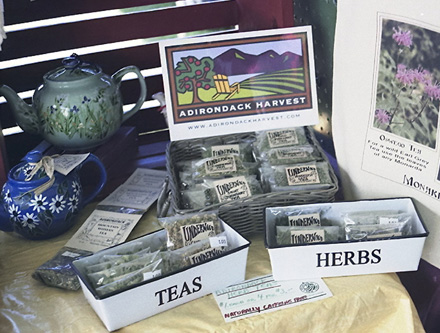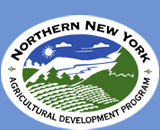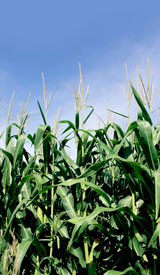September 26, 2007
Contact: Katherine Lang, North Country Regional Foods Initiative,
315-379-9192 x261
Note to reporters: Katherine Lang can put you in touch with local
entrepreneurs for your area
Jpg by request to karalynn@gisco.net:
Underwood Herbs of Chateaugay incorporates the Adirondack Harvest logo
in its product displays.

North Country Regional Foods Initiative Begins: Will Measure & Enhance
Economic Impact of Local Products
More and more farmers in Northern New York are selling the food they
grow to local consumers. The 2007 Empire State Poll by the Cornell
University Survey Research Institute showed that 78.5 percent of the New
York State residents age 18 and older surveyed buy local foods (37.4
percent said they go out of their way to buy local food). But just how
much revenue do the direct-marketed foods generate for the regional
economy and is there room to expand the economic impact of
locally-produced fresh and processed products? These are some of the
questions the new North Country Regional Foods Initiative project will
answer.
A team representing each of the North Country counties and Cornell
University staff will assess the economic impacts of regional food
production. A grant of $60,000 in federal Economic Development
Administration University Center funding is going directly to the
Cornell Cooperative Extension Associations of Clinton, Essex, Franklin,
Hamilton, Jefferson, Lewis and St. Lawrence counties to collaborate with
the Community and Rural Development Institute at Cornell University.
North Country Regional Foods Initiative Project Coordinator Katherine
Lang expects the project will engage local farmers, food processors, and
elected officials and community leaders who recognize the value of
agriculture and farm-based food entrepreneurs. Lang says, �We will
initially capture the impacts of current local food initiatives in the
North Country and then offer training and provide educational materials
to strengthen those efforts and extend the benefits they provide to the
region. This project is meant to build on the strong agricultural base
that already exists in the North Country and to add to it through
increased and strategic investment in local food initiatives.�
Examples of Local Food Initiatives: Multi-County Adirondack Harvest
The Adirondack Harvest local products initiative that began in Essex
County in 2001 now has more than 174 participating farms in Essex,
Clinton, Franklin, Hamilton, Jefferson, Lewis,
St. Lawrence, and Warren counties. Adirondack Harvest promotes regional
products through farm tours, farmers� markets and events, a website (adirondackharvest.com),
newsletters and a farm-to-restaurant program. The array of local
products includes apples and cider, baked goods made with locally-grown
wheat, cold hardy grapes and wine, assorted condiments, dairy products,
eggs, fruits and berries, herbs, honey, jams and jellies, maple syrup
and confections, meats, and vegetables.
Cornell Cooperative Extension of Essex County Executive Director Anita
Deming, says, �One of the goals of Adirondack Harvest is to increase the
opportunities to enhance profitable, sustainable agricultural production
through the sale of high-quality food and farm products. Local consumers
benefit from the expanded selection of fresh, locally-produced foods and
from keeping local land in production. The North Country Regional Foods
Initiative will measure the direct benefit to the region in terms of
dollars and other economic impact factors.�
St. Lawrence County: North Country Grown Cooperative, Inc.
Although honey producer Mark Berninghausen of Squeak Creek Honey
Company, Brasher Falls (St. Lawrence County), NY, was selling to schools
before the farm-to-school movement began, he says participating with
Adirondack Harvest and the North Country Grown Cooperative, based in
Canton, has �increased my direct market customer base to more colleges
and restaurants, and has increased volume of sales. Although I like
hands-on control of my product distribution, the warehousing and
distribution made possible by the North Country Grown Cooperative has
cost-effective advantages and I can see the regional foods marketplace
getting even wider.�
Lewis County: Maple Weekend, Lowville Farmers� Market, Cream Cheese
Festival
An annual March Maple Weekend opens 14 sugarhouses in Lewis, Jefferson
and St. Lawrence counties for direct sales. Maple Weekend Coordinator
Barbara Zehr says the 2007 event brought
an estimated 8,136 visitors to the maple producers with $47,376 in sales
reported for the sugarhouses, pancake houses and local businesses.
Zehr says, �The data from this visitor survey shows how the activity at
the production sites impacts the economies of the local communities. We
expect the North Country Regional Foods Initiative to broaden this type
of data for Northern New York and to inspire additional local investment
in direct marketing opportunities not only for maple producers but for
all types of agricultural producers and local food outreach and
marketing efforts.�
Organic vegetable grower Dolores DeSalvo manages the Lowville Farmers
Market that has grown from six sellers in 1988 to more than 25 vendors
at the Lewis County Fairgrounds this year. DeSalvo says, �The market is
growing to meet customer demand. We have seen as many as 1,000 people at
the market in one day.�
DeSalvo says the gross income of the Lowville Farmers Market has
steadily increased since 1997 when sales approached $90,000. She adds
that market vendors are seeing increasing use of Farmers� Market
Nutrition Program coupons by senior citizens and low-income families
purchasing fresh and processed foods.
Lewis County Manager Joe Baruth says Maple Weekend, the Lowville
Farmers� Market and the recent Cream Cheese Festival are helping to
increase tourism and revenues from bed and sales taxes.
�These local initiatives create opportunities for small entrepreneurs to
sell their products not only to local folks, but also to visitors coming
here from states away. Our chefs and restaurant owners and stay-at-home
moms are looking at their choices to serve local, fresh-from-the-field
and organically-grown produce,� Baruth says.
Jefferson County: Farmers� Markets, CSA, Farm-to-School
Vegetable grower Delta Keeney of Watertown, NY, participates in several
farmers� markets, a multiple grower CSA (Community-Supported Agriculture
where shares of the harvest are purchased by members at the start of the
season), and farm-to-school sales in Jefferson County.
�The local food initiatives in Jefferson County intertwine and have
amazing support from agencies such as Cooperative Extension, the Office
for the Aging, the Community Food Security Program, Public Health and
Social Services agencies, and the Jefferson County Agricultural
Development Program. The CSA and farm-to-school program are guaranteed
sales for the growers,� Keeney says.
Keeney says that the pilot program encouraging moderate to low-income
families to redeem food stamps and Farmers� Market Nutrition Program
coupons at local farmers� markets is in its third year and has increased
grower sales. She says the six growers participating in the Miracles by
the Acres CSA have all increased the size of their gardens to meet sales
demand and that farm-to-school sales doubled for the participating
growers in 2007.
At South Jefferson Central School, Food Service Director Cindy Harnas
says, �We have increased our purchasing of local foods by seventy
percent over the past six years. We served much more local produce
during our summer feeding program this year and this fall everything on
the salad bar and for vegetables in the serving line is purchased from
six local farmers,�
Harnas says the South Jefferson students are accepting the local foods
and willing to try new items such as the sweet peppers and lemon
cucumbers, and her staff is excited to work with the local farmers who
are also �our neighbors.�
The funding for the North Country Regional Foods Initiative comes from
the U.S. Department of Commerce through the Economic Development
Administration University Center designated for New York State at
Cornell University and hosted by Cornell�s Community and Rural
Development Institute (CaRDI). For more information on CaRDI, contact
Rod Howe, 607-255-2170,
rlh13@cornell.edu or visit
www.oed.cornell.edu.
To learn more about the North Country Regional Foods Initiative Project,
contact Katherine Lang at 315-379-9192 x261. # # #



